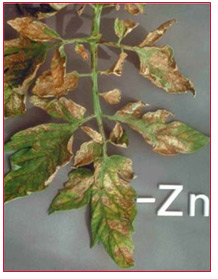Zinc is involved in a range of enzyme reactions similar to manganese and magnesium. It is important for the development and function of growth regulators (e.g. auxin) that influence internode elongation. It is also involved in chloroplast development.
 In the early stages of zinc deficiency the younger leaves become yellow and pitting develops in the interveinal upper surfaces of the mature leaves. As the deficiency progresses these symptoms develop into an intense interveinal necrosis but the main veins remain green, as in the symptoms of recovering iron deficiency.
In the early stages of zinc deficiency the younger leaves become yellow and pitting develops in the interveinal upper surfaces of the mature leaves. As the deficiency progresses these symptoms develop into an intense interveinal necrosis but the main veins remain green, as in the symptoms of recovering iron deficiency.
Zinc can be applied throughout the season. Applications should ensure sufficient zinc is available prior to flowering. Foliar applications are the most appropriate means of treating a deficiency. Deficiencies occur only rarely in greenhouse crops.
The internodes are thinner and shortened (by one third to half compared to normal plants) giving the plant a rosetted appearance. Leaves are small and thicker giving a ‘leathery’ appearance. Because the leaf hairs are dense, the smaller leaves take on a silvery gray green sheen. Irregular yellowish green chlorotic blotches appear on the leaves. These may develop into brown necrotic lesions over the whole leaf. Leaves die and fall off; flowers die back. Any fruit developing will remain small and ripen prematurely. High phosphorus levels or anaerobic conditions can induce deficiencies. Where excess zinc is available, plants exhibit symptoms close to that for iron deficiency – i.e. chlorosis of young leaves.
 In the early stages of zinc deficiency the younger leaves become yellow and pitting develops in the interveinal upper surfaces of the mature leaves. As the deficiency progresses these symptoms develop into an intense interveinal necrosis but the main veins remain green, as in the symptoms of recovering iron deficiency.
In the early stages of zinc deficiency the younger leaves become yellow and pitting develops in the interveinal upper surfaces of the mature leaves. As the deficiency progresses these symptoms develop into an intense interveinal necrosis but the main veins remain green, as in the symptoms of recovering iron deficiency.The internodes are thinner and shortened (by one third to half compared to normal plants) giving the plant a rosetted appearance. Leaves are small and thicker giving a ‘leathery’ appearance. Because the leaf hairs are dense, the smaller leaves take on a silvery gray green sheen. Irregular yellowish green chlorotic blotches appear on the leaves. These may develop into brown necrotic lesions over the whole leaf. Leaves die and fall off; flowers die back. Any fruit developing will remain small and ripen prematurely. High phosphorus levels or anaerobic conditions can induce deficiencies. Where excess zinc is available, plants exhibit symptoms close to that for iron deficiency – i.e. chlorosis of young leaves.


.jpg)









